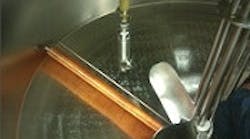The kinds of features you look for in the machines you use to clean other machines are ... probably very similar to those you seek in all your machines. Consider this short list of attributes:
- Reduced cleaning and clean-in-place (CIP) cycle times
- Low consumption of water, energy and cleaning chemicals
- Fast, simple service and maintenance procedures
- Compact design to fit limited floor space and tight spaces on the line
- A high assurance of consistently thorough cleaning to extend service intervals and extend overall service life of equipment
- Attention to engineering details for reliable, repeatable results.
Fast, easy maintenance has driven development of new CIP tank-washing systems, such as the HydroWhirl Orbitor from Bete Fog Nozzle, Greenfield, Mass., maker of spray nozzles and fabricated cleaning assemblies.
"It's designed as a simple, reliable dependable machine for tank washing that will always give you the same level of performance, or repeatability, while providing a device the customer can service at their location with simple tools," says Noah Wallace, applications engineer. The rotating, self-cleaning, self-lubricating system reduces CIP cycle times while minimizing water, energy and chemical consumption. For this class of products, on-site service is a major development.
Maintenance tools and spare parts stores are streamlined compared to traditional designs. In the past, rebuilding typically required the user to remove the unit and ship it back to the factory for rebuilding. If needed, the customer would install a new one while the rebuild is under way. Now, a simple rebuild kit of common wear parts (seals, bushings) replaces complete redundant units, and an in-house rebuild can be done in as little as 15 minutes.
Breweries, wineries and many other processes with large tanks use this type of spray washer for process vessels and storage silos. The unit is offered in various sizes (up to 130 ft. in diameter); nozzle configurations (two or four) and wash patterns (360 and 180 degrees) to handle mild jobs to wild ones such as vessels with caked-on contaminants.
Gamajet, an Exton, Pa., part of Alfa Laval, also offers rotary spray-nozzle tank cleaners for large vessels. The latest is the PowerFlex, a versatile, sanitary rotary impingement machine that scours tank interiors in a precise, repeatable and reliable, 360-degree cleaning. The self-cleaning, and self-draining units operate at low pressures (50-100 psi) and maintain 8-15 lbs. of force. They can be operated at a variety of pressures and flows.
The company claims significant increases in productivity and significantly reduced cleaning times, chemical and water use; as well as confined-space entry and overall satisfaction with cleaning effectiveness.
"In one case, the PowerFlex was sold to a customer who previously spent 18 hours manually cleaning only to fail inspection tests," says Alexandra Talarico of Gamajet marketing.
"The PowerFlex was installed and cleaning was reduced from 18 hours to 23 minutes — saving time, labor and money." The unit has also enabled food & beverage companies to meet their annual water savings goals, she adds.
Douglas Machines, Clearwater, Fla., offers industrial washers that can be run in batch or continuous mode to quickly and efficiently clean thousands of containers per hour of pans, trays, totes, moulds, scale parts, screens, pallets, lugs, racks, barrels, smoke trucks, bins, vats, barrels and buckets.
The company's latest Scale Parts Washers were developed in cooperation with manufacturers of multihead weighers – a particularly tricky machine to clean. The company claims the washers can quickly and efficiently wash, rinse and sanitize "all brands" of equipment in as little as 5 minutes -- a far cry from manual cleaning.
Specialized wash racks can be loaded at the weigh station and transported to the washer for easy cleaning. Plants can install the washer on a mezzanine or in a centralized wash room.
In addition to the benefits of consistency, efficiency, sustainability and labor benefits that an automated washer can bring, the new version of Douglas' washers come with optional data loggers to track wash and rinse cycle times, wash and rinse temperatures and water pressures to help comply with food safety requirements. Kevin Lemen, vice president of sales & marketing, adds that new sanitary design features include "sloped roofs and continuous welds [to help] meet today's high standards for cleanliness and sanitation for both customers and regulators" while standardizing the cleaning process."


